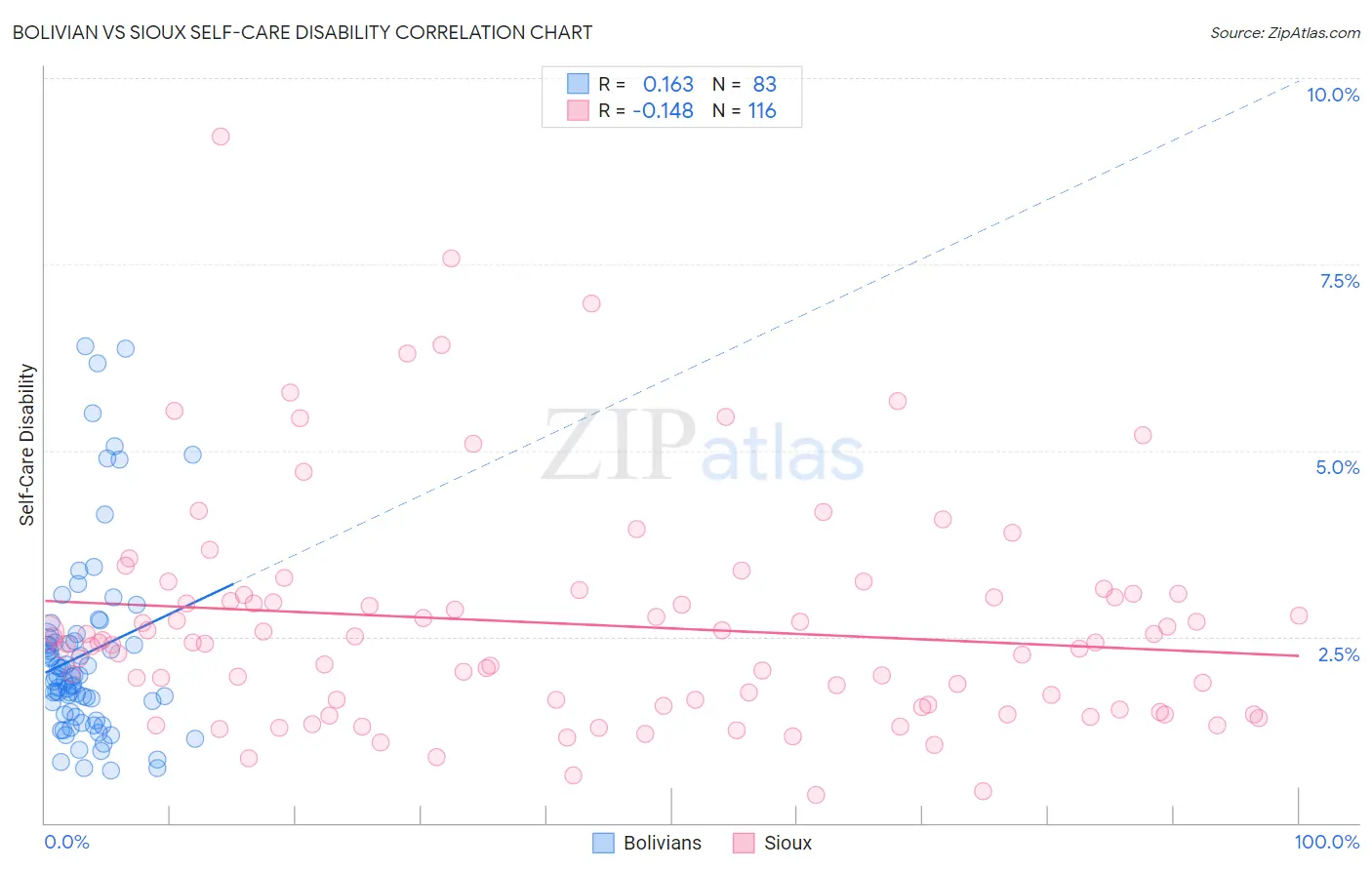Bolivian vs Sioux Self-Care Disability
COMPARE
Bolivian
Sioux
Self-Care Disability
Self-Care Disability Comparison
Bolivians
Sioux
2.2%
SELF-CARE DISABILITY
100.0/ 100
METRIC RATING
8th/ 347
METRIC RANK
2.5%
SELF-CARE DISABILITY
24.6/ 100
METRIC RATING
190th/ 347
METRIC RANK
Bolivian vs Sioux Self-Care Disability Correlation Chart
The statistical analysis conducted on geographies consisting of 184,600,652 people shows a poor positive correlation between the proportion of Bolivians and percentage of population with self-care disability in the United States with a correlation coefficient (R) of 0.163 and weighted average of 2.2%. Similarly, the statistical analysis conducted on geographies consisting of 233,917,854 people shows a poor negative correlation between the proportion of Sioux and percentage of population with self-care disability in the United States with a correlation coefficient (R) of -0.148 and weighted average of 2.5%, a difference of 15.7%.

Self-Care Disability Correlation Summary
| Measurement | Bolivian | Sioux |
| Minimum | 0.71% | 0.38% |
| Maximum | 6.4% | 9.2% |
| Range | 5.7% | 8.8% |
| Mean | 2.3% | 2.7% |
| Median | 2.0% | 2.4% |
| Interquartile 25% (IQ1) | 1.5% | 1.6% |
| Interquartile 75% (IQ3) | 2.5% | 3.1% |
| Interquartile Range (IQR) | 1.0% | 1.5% |
| Standard Deviation (Sample) | 1.3% | 1.5% |
| Standard Deviation (Population) | 1.3% | 1.5% |
Similar Demographics by Self-Care Disability
Demographics Similar to Bolivians by Self-Care Disability
In terms of self-care disability, the demographic groups most similar to Bolivians are Immigrants from Bolivia (2.2%, a difference of 0.050%), Immigrants from Nepal (2.2%, a difference of 0.14%), Filipino (2.2%, a difference of 0.26%), Zimbabwean (2.2%, a difference of 0.51%), and Sudanese (2.2%, a difference of 1.4%).
| Demographics | Rating | Rank | Self-Care Disability |
| Yup'ik | 100.0 /100 | #1 | Exceptional 1.9% |
| Immigrants | India | 100.0 /100 | #2 | Exceptional 2.0% |
| Thais | 100.0 /100 | #3 | Exceptional 2.1% |
| Immigrants | Singapore | 100.0 /100 | #4 | Exceptional 2.1% |
| Zimbabweans | 100.0 /100 | #5 | Exceptional 2.2% |
| Filipinos | 100.0 /100 | #6 | Exceptional 2.2% |
| Immigrants | Bolivia | 100.0 /100 | #7 | Exceptional 2.2% |
| Bolivians | 100.0 /100 | #8 | Exceptional 2.2% |
| Immigrants | Nepal | 100.0 /100 | #9 | Exceptional 2.2% |
| Sudanese | 100.0 /100 | #10 | Exceptional 2.2% |
| Immigrants | South Central Asia | 100.0 /100 | #11 | Exceptional 2.2% |
| Immigrants | Ethiopia | 100.0 /100 | #12 | Exceptional 2.2% |
| Ethiopians | 100.0 /100 | #13 | Exceptional 2.2% |
| Luxembourgers | 100.0 /100 | #14 | Exceptional 2.2% |
| Okinawans | 100.0 /100 | #15 | Exceptional 2.2% |
Demographics Similar to Sioux by Self-Care Disability
In terms of self-care disability, the demographic groups most similar to Sioux are Moroccan (2.5%, a difference of 0.11%), Soviet Union (2.5%, a difference of 0.16%), Immigrants from Eastern Europe (2.5%, a difference of 0.21%), Immigrants from Oceania (2.5%, a difference of 0.22%), and Ukrainian (2.5%, a difference of 0.22%).
| Demographics | Rating | Rank | Self-Care Disability |
| Salvadorans | 36.4 /100 | #183 | Fair 2.5% |
| Yugoslavians | 36.1 /100 | #184 | Fair 2.5% |
| Slavs | 34.3 /100 | #185 | Fair 2.5% |
| Immigrants | El Salvador | 33.0 /100 | #186 | Fair 2.5% |
| Irish | 28.7 /100 | #187 | Fair 2.5% |
| Immigrants | Oceania | 28.3 /100 | #188 | Fair 2.5% |
| Immigrants | Eastern Europe | 28.0 /100 | #189 | Fair 2.5% |
| Sioux | 24.6 /100 | #190 | Fair 2.5% |
| Moroccans | 22.9 /100 | #191 | Fair 2.5% |
| Soviet Union | 22.2 /100 | #192 | Fair 2.5% |
| Ukrainians | 21.4 /100 | #193 | Fair 2.5% |
| Immigrants | Germany | 17.9 /100 | #194 | Poor 2.5% |
| Immigrants | Southern Europe | 15.6 /100 | #195 | Poor 2.5% |
| Koreans | 15.5 /100 | #196 | Poor 2.5% |
| Crow | 15.2 /100 | #197 | Poor 2.5% |